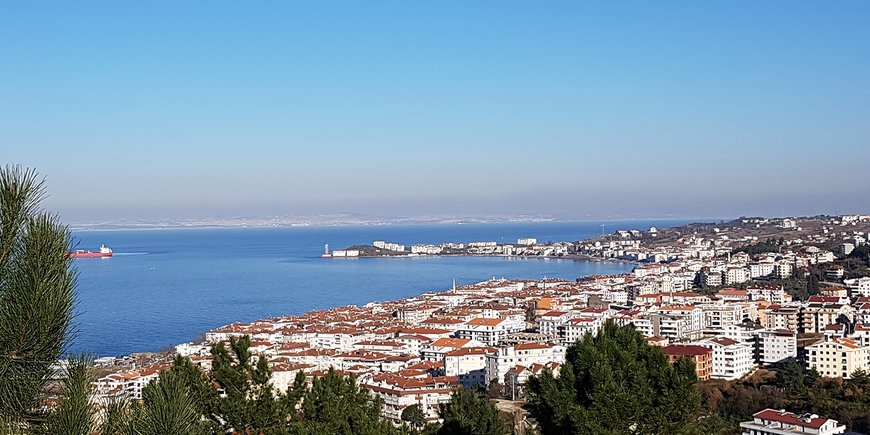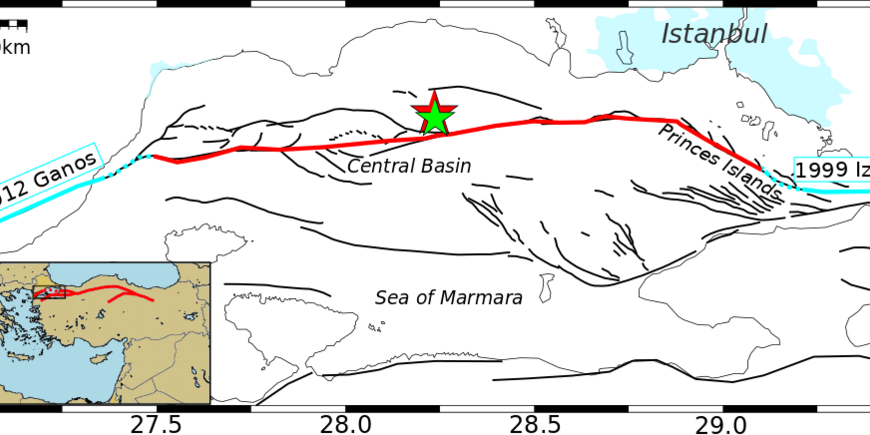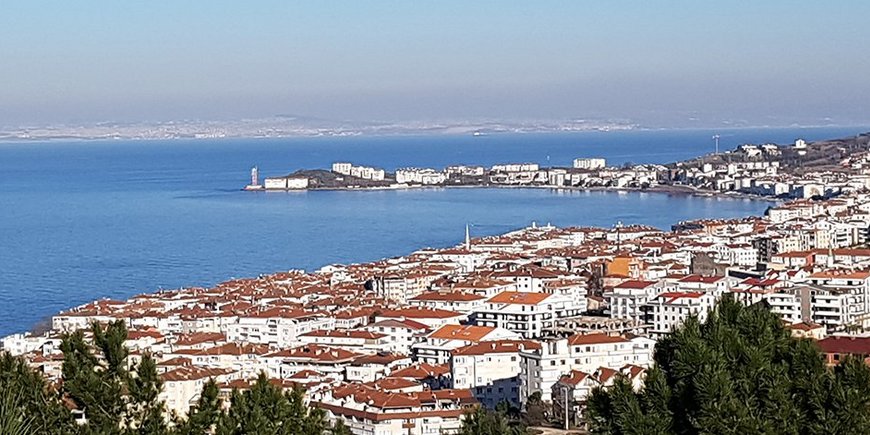The 16-million population center of Istanbul is facing a tremendous seismic hazard and risk due a pending major earthquake along the North Anatolian Fault below the Sea of Marmara. This fault is a major plate boundary that crosses northern Turkey from east to west, and that produced several destructive earthquakes during the 20th century. The series of large earthquakes included an event in Erzincan in eastern Turkey in 1939. Since then, the subsequent earthquakes moved steadily westwards reaching the Marmara region in 1999. The only portion of the entire plate-bounding fault that did not break since 1766 is the segment below the Sea of Marmara immediately to the south of Istanbul. There, a large earthquake with magnitude M larger than 7 is overdue and might occur anytime. Yet, in September 2019, a sequence of two nearly collocated moderate earthquakes (M4.7 and M5.8) occurred in the center of this hazardous fault portion. These two events were largely felt in Istanbul, and reminded people of the possibility of a large earthquake hitting the megalopolis.
The GFZ Potsdam has a research focus in the broader Istanbul region and recently implemented the geophysical observatory GONAF (www.gonaf-network.org) to study ongoing tectonic processes with unprecedented detail. Using seismometer recordings from regional seismic networks and in particular from GONAF, it was possible to detect small earthquakes that were accompanying the two mainshocks. The analysis of these small events revealed that the September 2019 earthquakes were preceded by a number of foreshocks. While some of them are distributed along the whole length of the fault segment, others were concentrating around the nucleation point of the two larger earthquakes. These observations suggest that a preparation process occurred during the two days preceding each earthquake. Furthermore, this process was accelerated during the hours preceding the earthquakes leading to the larger events. During the days preceding the earthquakes, the entire final rupture length of the rupture was illuminated by small earthquakes. This raises the question of the existence of a link between the size of the foreshock-activated region and the final magnitude of the mainshock.
While observations of foreshocks preceding large earthquakes like the tsunami-generating Tohoku/Japan M9 2011 and Iquique/Chile M8.1 2014 earthquakes are now common, this study reports equivalent observations of small seismicity preceding moderate earthquakes. “These observations support the hypothesis that earthquakes are not a completely random process and that they are preceded by a detectable preparation phase lasting from several hours to several days”, says Dr. Virginie Durand, lead author of the study. Therefore, these results are encouraging to complement existing early-warning systems that can ultimately lead to an extended warning time for people.
The study was performed as part of the Young Investigators Group SAIDAN led by Dr. Patricia Martínez-Garzón, who says that “this type of observations may serve to improve operational earthquake forecasting systems, provided the existence of densified seismic monitoring networks near active faults, like the GONAF in the Istanbul region, and of near-real time processing of earthquake recordings.”
Original study: A Two-Scale Preparation Phase Preceded an M w 5.8 Earthquake in the Sea of Marmara Offshore Istanbul, Turkey, Durand, V., S. Bentz, G. Kwiatek, G. Dresen, C. Wollin, O. Heidbach, P. Martínez-Garzòn, F. Cotton, M. Nurlu, and M. Bohnhoff (2020). , Seismol. Res. Lett., 1–9, doi: 10.1785/0220200110
Scientific contact (English / French):
Dr. Virginie Durand
Scientist at GFZ Section 4.2 Geomechanics and Scientific Drilling
Helmholtz Centre Potsdam
German Research Centre for Geosciences GFZ
Telegrafenberg
14473 Potsdam
e-mail: virginie.durand@gfz-potsdam.de
phone: +49 331 288-27502
Scientific contact (English / German):
Prof. Dr. Marco Bohnhoff
Head of GFZ Section 4.2 Geomechanics and Scientific Drilling
Professor of Experimental and Borehole Seismology at Free University Berlin
Executive Director of the International Continental Scientific Drilling Program
Helmholtz Centre Potsdam
German Research Centre for Geosciences GFZ
Telegrafenberg
14473 Potsdam
e-mail: bohnhoff@gfz-potsdam.de
phone: +49 331 2881327
Media contact:
Josef Zens
Head of Public and Media Relations
Helmholtz Centre Potsdam
German Research Centre for Geosciences GFZ
Telegrafenberg
14473 Potsdam
e-mail: josef.zens@gfz-potsdam.de
phone: +49-331-288-1040










![[Translate to English:] Torsten Sachs in front of a climate station on a field](/fileadmin/_processed_/3/9/csm__TorstenSachs_bearbeitet_GS_4a1365ef84.jpeg)

![[Translate to English:] left image flood at the Ahrtal: image from above, several houses are flooded; left image:: Heidi Kreibich;](/fileadmin/_processed_/4/4/csm_Bild2_9af0130e9f.png)



![[Translate to English:] Start der Vega Rakete](/fileadmin/_processed_/6/4/csm_20231201-kachel_Vega-VV23-launch_ESA-CNES-Arianespace_706716b68c.jpeg)









![[Translate to English:] Poster exhibition at the Brandenburg Hydrogen Day at the GFZ, some participants in the foreground](/fileadmin/_processed_/6/5/csm_Erster_Brandenburgischer_Wasserstofftag_GFZ_402fcec95e.jpeg)
![[Translate to English:] Group picture of the participants](/fileadmin/_processed_/9/4/csm_20231108_CAWa-Workshop-Tashkent_Gruppenbild_99ea779d8a.jpeg)

![[Translate to English:] [Translate to English:] Hörsaal](/fileadmin/_processed_/e/6/csm_H%C3%B6rsal_e21ac645fb.jpeg)


![[Translate to English:] The Delegations in the Historic Library on the Telegrafenberg. In the back there are from left to right, the Dutch Ambassador for Germany, Ronald van Roeden, the Dutch Minister for Education, Culture and Science, Robbert Dijkgraaf and the scientific director of the GFZ, Susanne Buiter.](/fileadmin/_processed_/d/b/csm_Kachel-2_9eba4b4212.jpeg)

